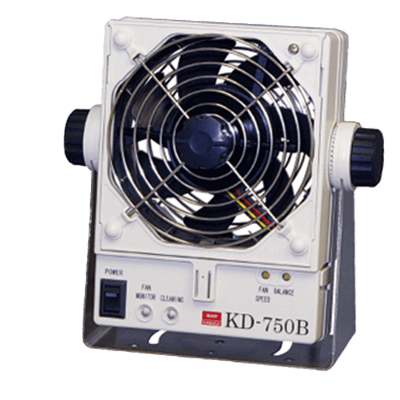What Is an Air Ionizer?
 An air ionizer is a device that removes static electricity generated at manufacturing sites, etc., which can cause machine malfunctions. An air ionizer is also called a static electricity eliminator or slow electricity.
An air ionizer is a device that removes static electricity generated at manufacturing sites, etc., which can cause machine malfunctions. An air ionizer is also called a static electricity eliminator or slow electricity.
An object charged with static electricity has an imbalance between positive and negative electricity. The air ionizer strikes the charged object with static-charged particles (ions).
In this way, the principle of the air ionizer is to change a charged object into an electrically balanced state, i.e., a state without static electricity. Specifically, air ionizer is used to prevent foreign objects from adhering to food trays and cups by eliminating static electricity inside them, and to prevent static electricity destruction in camera modules.
Types and features of Air Ionizers
This section describes the types and features of air ionizers. Air ionizers generally have evaluation items such as static elimination speed and ion balance, but there are several types in the principle of how ions are generated from the ionizer.
1. Voltage-Applied Method
There are several types of air ionizer methods, including the corona discharge method, which irradiates ions generated by corona discharge, the soft X-ray method, which irradiates weak X-rays, and the radiation method, which irradiates α-rays and β-rays, but the corona discharge method is most commonly used for safety and economic reasons.
The electrostatic remover (device, etc.) is charged positively or negatively, and there are two types of ion irradiation methods: the AC method and the DC method.
Corona Discharge
Corona discharge is a discharge phenomenon that occurs when a high voltage is applied to a thin local area, which produces ions. Corona discharge air ionizers utilize this principle to intentionally generate ions, which are then irradiated to remove static electricity.
AC Method
A single discharge needle alternately generates positive and negative ions. This method uses the AC voltage from the outlet as it is, and has a good ion balance, but is characterized by a slow static elimination speed.
DC Method
This method generates positive/negative ions from each of the two discharge needles. Since DC voltage is continuously applied, the ion polarity is either positive or negative.
2. Types by Application
There are four types of air ionizers for different applications. Therefore, it is necessary to consider the installation environment and conditions and select the most effective type.
Bar Type
This is a bar-shaped air ionizer. It is suitable for high-speed static elimination over a wide area and has the highest basic performance.
Spot Nozzle Type
This type of air ionizer removes static from a small area through a nozzle. Its small size enables pinpoint ionization of small areas.
Fan Type
This type of air ionizer uses airflow generated by a fan to spray out ions. The static elimination range is narrower than that of the bar type, but it is compact and can be used on a tabletop.
Gun Type
This type of air ionizer emits ions in combination with compressed air. In addition to static elimination, it can also simultaneously remove foreign matter adhering to surfaces.
How to select Air Ionizers
There are three main factors in selecting air ionizers: static elimination distance, static elimination range, and static elimination speed. Since each type has different characteristics, it is necessary to carefully consider the relationship between the object to be ionized and the air ionizers.
1. Elimination Distance
The static elimination distance is the distance that the air ionizers can eliminate static from the object. For example, spot nozzle-type air ionizers have a small static elimination distance due to their small size, while bar-type air ionizers can eliminate static at a distance of 1 m or more.
2. Static Elimination Range
The static elimination range is the length of the width direction that the air ionizers can eliminate static. Bar-type air ionizers can eliminate static over 1 m, while blower-type air ionizers can eliminate static over less than 1 m. Therefore, it is necessary to consider how large an area is to be ionized.
3. Ionizing Speed
The static elimination speed is a performance indicator of how long it takes an air ionizer to eliminate static. The shorter the speed, the higher the performance of the air ionizers.